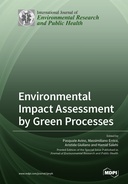Explore

Environmental Impact Assessment by Green Processes
0 Ungluers have
Faved this Work
Login to Fave
Primary energy consumption around the world has been increasing steadily since the Industrial Revolution and shows no signals of slowing down in the coming years. This trend is accompanied by the increasing pollutant concentration on the Earth’s biosystems and the general concerns over the health and environmental impacts that will ensue. Air quality, water purity, atmospheric CO2 concentration, etc., are some examples of environmental parameters that are degrading due to human activities. These ecosystems can be safeguarded without renouncing industrial development, urban and economic development through the use of low environmental impact technologies instead of equivalent pollutant ones or through the use of technologies to mitigate the negative impact of high emissions technologies. Pollutant abatement systems, carbon capture technologies, biobased products, etc. need to be established in order to make environmental parameters more and more similar to the pre-industrialization values of the planet Earth. In 15 papers international scientists addressed such topics, especially combining a high academic standard coupled with a practical focus on green processes and a quantitative approach to environmental impacts.
This book is included in DOAB.
Why read this book? Have your say.
You must be logged in to comment.
Rights Information
Are you the author or publisher of this work? If so, you can claim it as yours by registering as an Unglue.it rights holder.Downloads
This work has been downloaded 97 times via unglue.it ebook links.
- 97 - pdf (CC BY) at Unglue.it.
Keywords
- abatement technology
- acute and chronic toxicity
- adsorption
- agricultural carbon emissions
- Air quality
- anaerobic digestion
- biochar
- Biomass
- carbon emissions
- carbon tax
- carbon tax recycling policy
- carbon tax recycling system
- CEO tournament incentive
- ceramic industry
- CGE model
- channeled emission
- China
- Chinese manufacturing enterprises
- Chinese provinces
- CO2 emission
- CO2 emissions
- crop production
- decoupling
- digestate
- double dividend
- economic growth
- economic performance
- EKC
- emission factor
- emissions trading system
- Energy Efficiency
- enterprise innovation
- environmental compliance
- environmental concerns
- environmental pollution
- environmental stringency policies
- Green Economy
- green innovation
- green organizational culture (GOC)
- green psychological climate (GPC)
- green total factor productivity
- History of engineering & technology
- Human development
- human resource management (HRM)
- hydroelectricity consumption
- industry structure
- innovative human capital
- liquid-solid separation
- LMDI
- low-carbon economy
- luminescent bacteria
- membrane fouling
- Membrane separation
- mineral dust
- n/a
- nutrient recovery
- panel cointegration and causality analyses
- particulate matter
- PM10, PM2.5, and PM1
- pollutant abatement technologies
- Saharan dust
- spatial difference-in-difference
- spatial heterogeneity
- state-owned enterprises
- syngas scrubber wastewater
- tax neutrality
- technological progress
- Technology, engineering, agriculture
- Technology: general issues
- tournament theory
- toxicity assessment
- triple dividend
- U-shaped relationship
- Urbanization
Links
DOI: 10.3390/books978-3-0365-5896-7Editions

